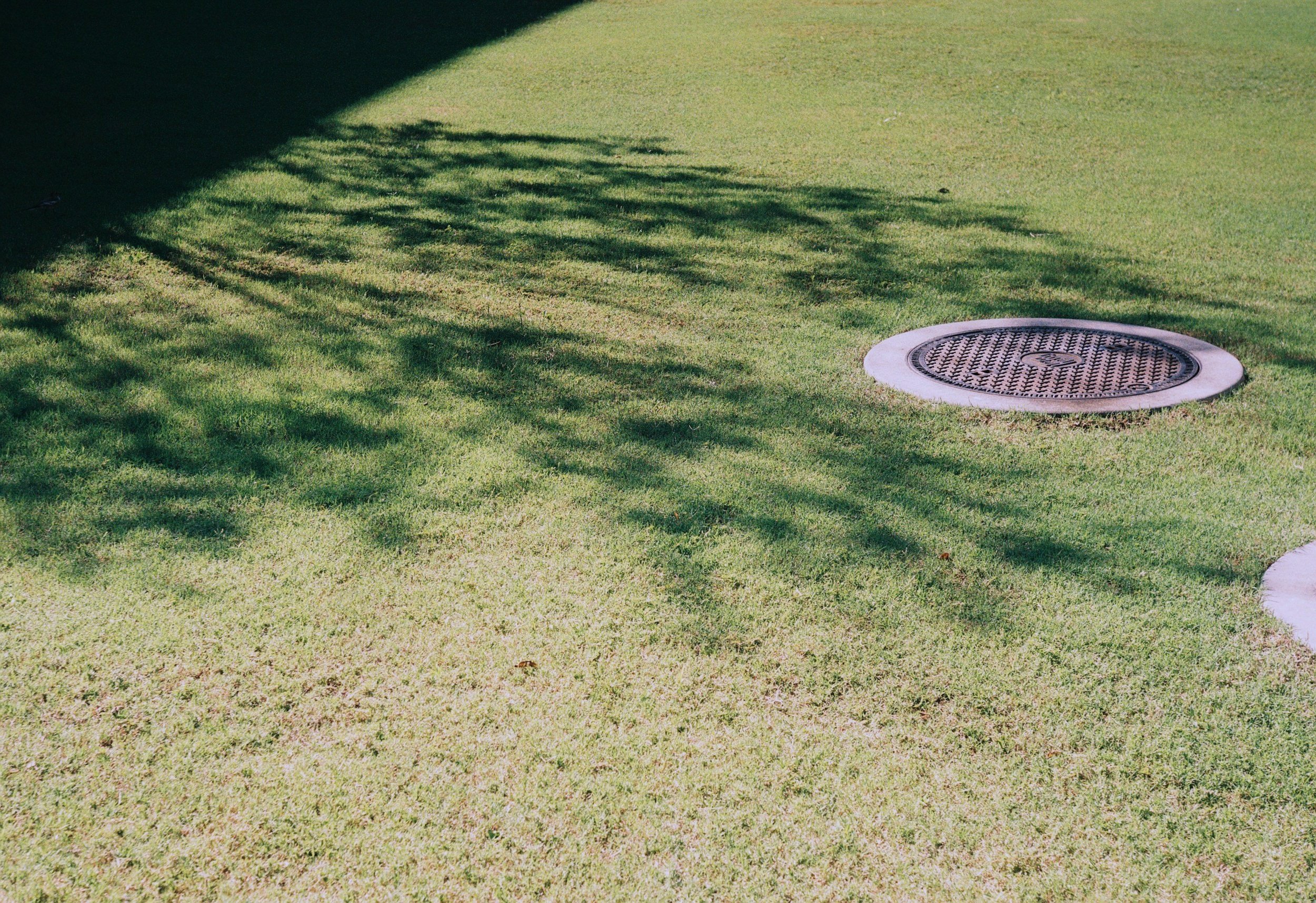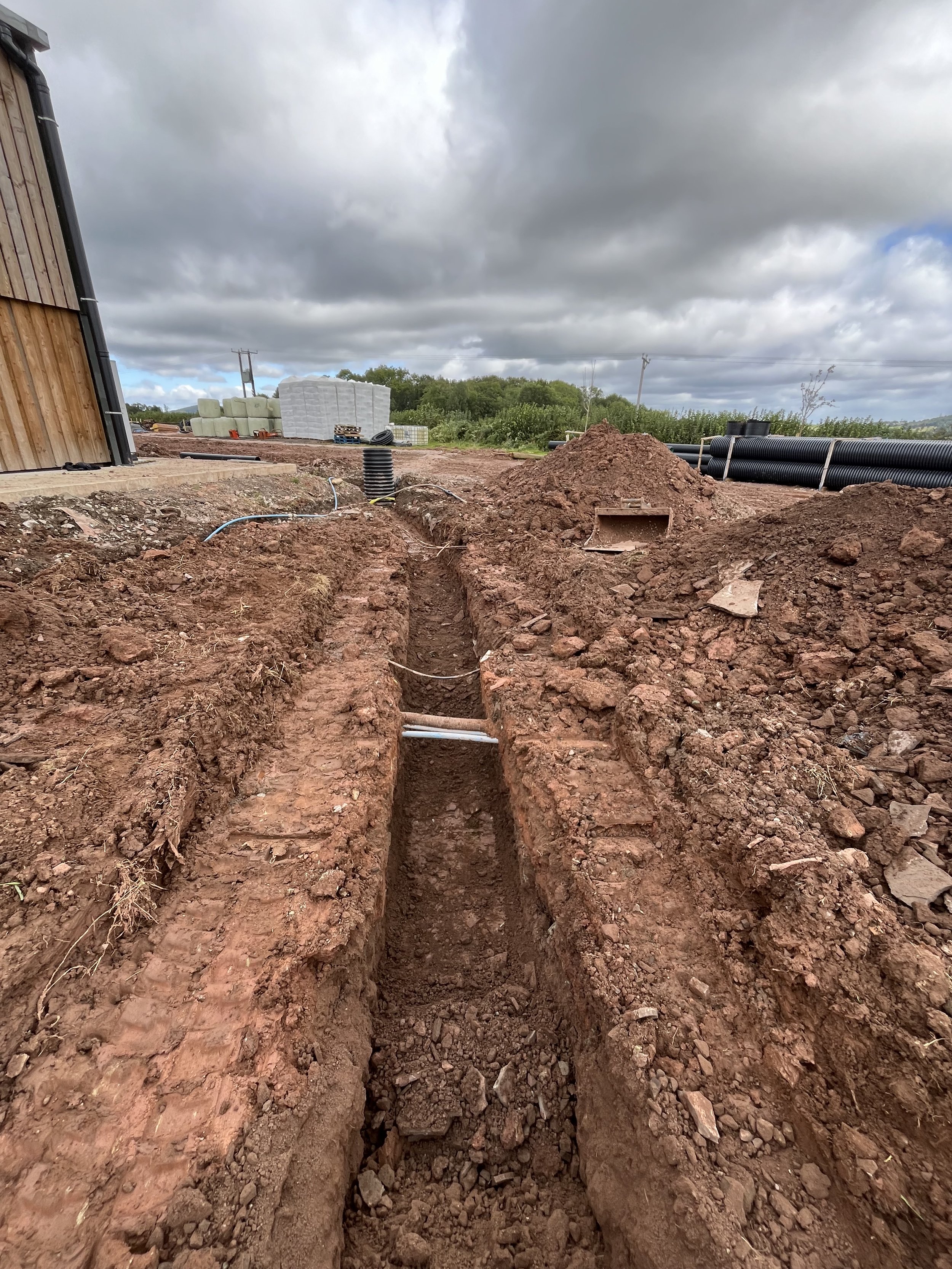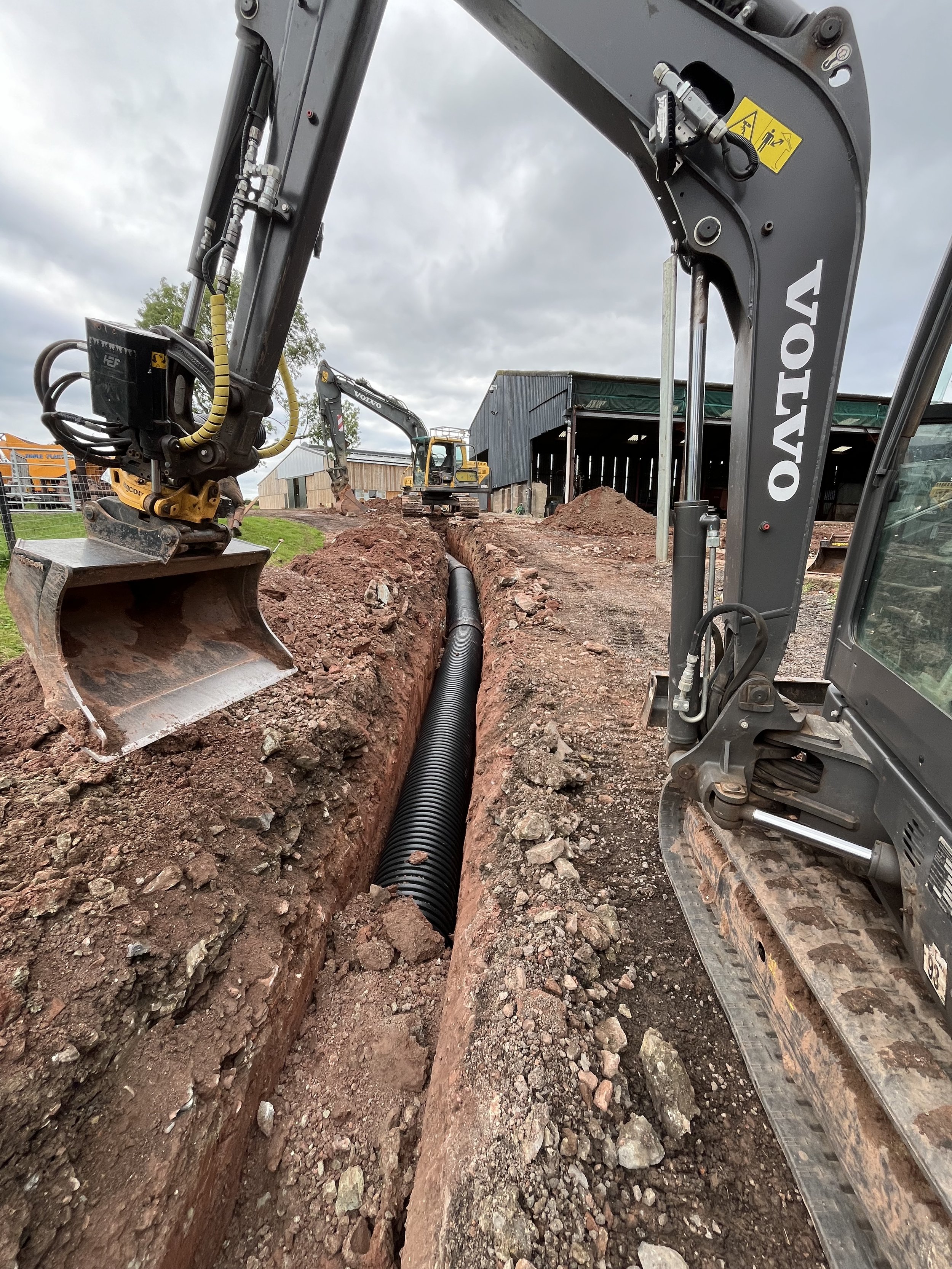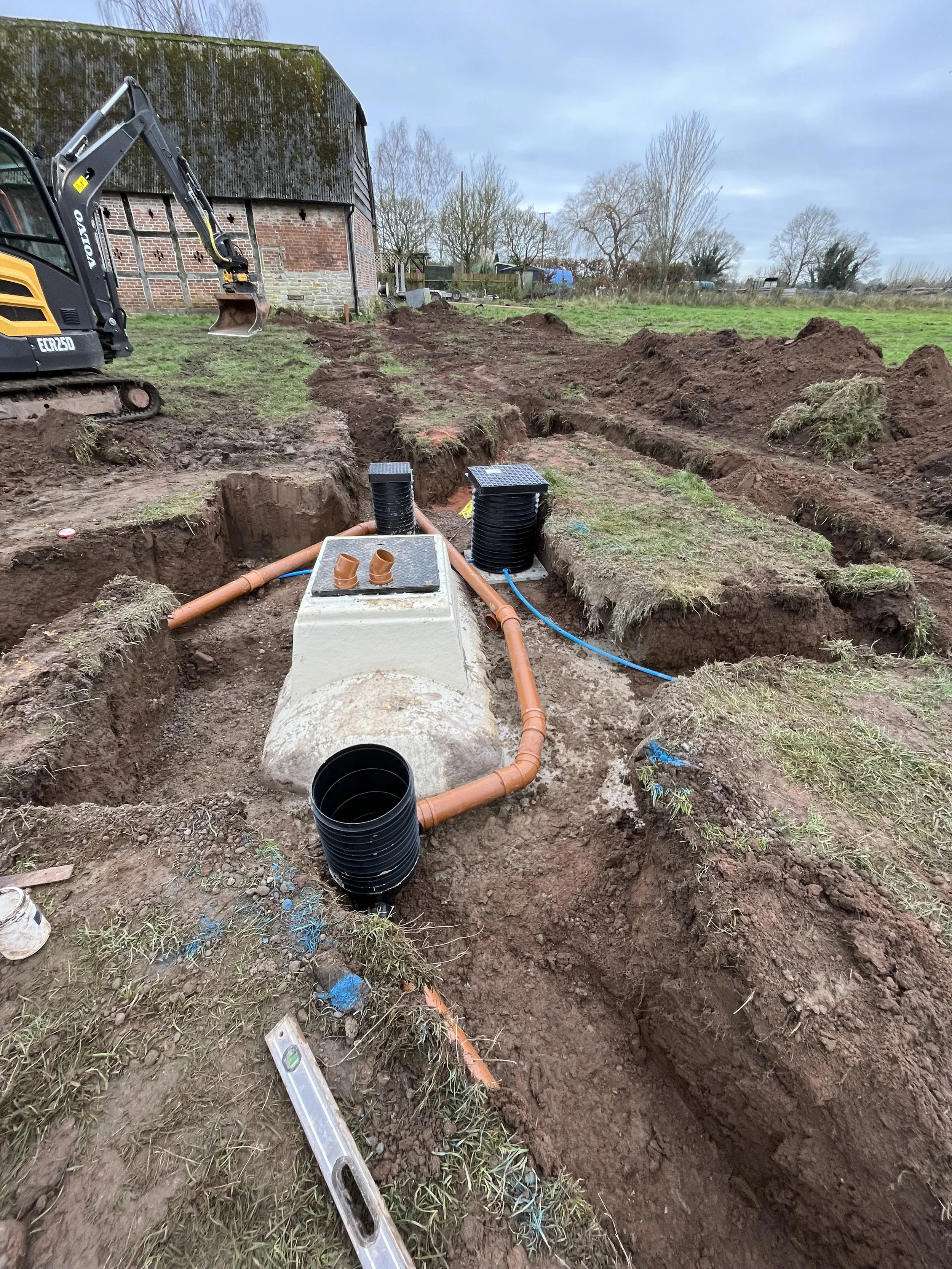
Septic Tank & Sewage Treatment Plant Installation
Complete, Compliant Solutions for Devon & Somerset
At Hillmoor, we specialise in delivering compliant septic tanks and sewage treatment plants tailored to you - whether that’s commercial, rural, agricultural, or an equestrian environment. Whether you're building from scratch orupgrading outdated infrastructure, we provide a full-service approach from consultation through to installation. We ensure everything is completed to legal standards and best practice guidelines.
Our experienced team handles every aspect of the process, including the design, supply, and installation of septic tanks, sewage treatment plants, and associated drainage systems. All of our installations are carried out in full compliance with current UK Building Regulations and Environment Agency guidelines, so you can be confident that your system is reliable, effective, and future-proof.
Septic Tanks & Sewage Treatment Works Installation
We are fully equipped to provide and install off-grid wastewater solutions, including septic tanks and modern sewage treatment systems that meet the latest environmental standards. For properties without access to mains drainage, these systems offer an efficient, sustainable way to manage waste—particularly important in remote areas or where planning restrictions apply.
Hillmoor offers:
Site surveys and soil percolation testing
Advice on choosing between a septic tank and treatment plant
Groundworks and excavation
Full installation and pipework integration
Discharge compliance and registration with the Environment Agency
Our team ensures that every stage—from planning to final inspection—is handled professionally, so your system is not only functional but fully compliant with the General Binding Rules for small sewage discharges in the UK.

Reliable, Experienced & Ready to Help
Whether it’s a full sewage treatment plant, a new trench for utilities, or a drainage solution for waterlogged paddocks, we provide a single point of contact to make the process as straightforward and stress-free as possible.
What is the new Septic Tank / Sewage Treatment Work UK Regulation?
In 2013 the UK Environment Agency started the groundwork for the new General Binding Rules (GBRs) that came into force in 2015. The rules are designed to protect the environment and simplify compliance for homeowners, but if your home isn't connected to the mains sewer and instead relies on a septic tank or small sewage treatment plant, these rules do apply to you.
Key Points of the Regulation
No direct discharge to surface water: Septic tanks can no longer release untreated waste into rivers, streams, or ditches. If yours does, you must upgrade to a compliant treatment system.
Proper maintenance: You must ensure your system is regularly emptied and maintained to prevent pollution.
Correct installation: New systems must be installed to meet current standards and must not pose a risk to health or the environment.
Permit-free if compliant: If your system meets all the rules, you don’t need an environmental permit.
What You Need to Know
If your property isn’t connected to the mains sewer and relies on a septic tank or small sewage treatment plant, it’s important to be aware of the regulations introduced by the Environment Agency in 2015. They apply to anyone who discharges wastewater from a septic tank or treatment plant into the ground or surface water.
One of the most significant changes is that septic tanks can no longer discharge untreated waste directly into surface water such as rivers, streams, or ditches. If your system currently does this, you are required to upgrade it—either by installing a small sewage treatment plant that produces cleaner effluent or by redirecting the discharge to a properly designed drainage field. This is essential to prevent pollution and protect local watercourses.
The rules also require that your system is properly maintained. This means arranging regular emptying by a registered waste carrier and ensuring that the system is in good working order. If your system is not maintained, it could cause pollution or health risks, and you could be held legally responsible.
For systems installed before 1 January 2015, the discharge is considered “existing,” but it must still comply with the General Binding Rules. If your system was installed or significantly altered after this date, additional requirements apply, particularly around the location of the discharge and the volume of wastewater being released.
The good news is that if your system meets all the criteria set out in the General Binding Rules, you don’t need to apply for an environmental permit. However, if your system doesn’t comply, action must be taken to bring it up to standard. This might involve upgrading your equipment or changing how and where your wastewater is discharged.
Understanding and complying with these rules is essential for protecting the environment and avoiding potential fines or enforcement action. If you're unsure whether your system is compliant, send us a message or give us a call, and we’ll be happy to talk it through with you.
What This Means for You
If your system was installed before 1 January 2015, it’s considered an “existing discharge” and must still meet the general rules.
If you’ve installed or significantly changed your system after this date, stricter rules apply, especially regarding location and discharge volume.
Need an Upgrade?
If your current system discharges to surface water or doesn’t meet the rules, you’ll need to replace it with a small sewage treatment plant that produces cleaner effluent, or, redirect the discharge to a drainage field that meets the latest standards. The first step is getting in contact with us - we’re more than happy to chat about options.
Septic Tanks Vs Sewage Treatment Plants
What is a Septic Tank?
A septic tank is an underground chamber made from concrete, plastic, or fibreglass that collects and treats domestic wastewater when a property is not connected to the mains sewer system. Wastewater from the household—such as from sinks, baths, and toilets—flows into the tank, where solids settle to the bottom to form sludge, and lighter materials like oils rise to the top to form a scum layer. The remaining liquid effluent exits the tank into a drainage field or soakaway system, where it is further filtered through the soil. Septic tanks offer a relatively simple and low-maintenance solution for wastewater treatment, but their effectiveness relies heavily on soil permeability and regular emptying to prevent blockages or contamination.
What is a Sewage Treatment Plant?
A sewage treatment plant, sometimes referred to as a package treatment plant, offers a more advanced method of treating wastewater on-site. These systems actively process sewage using mechanical or biological processes to break down waste to a much cleaner standard before discharge. The treated water is usually clean enough to be released directly into a watercourse, such as a stream or ditch, provided it complies with the Environment Agency's General Binding Rules. Treatment plants are required for properties where the ground conditions are unsuitable for a soakaway, or where higher environmental standards are necessary. While they tend to be more costly and complex than septic tanks, they are far more effective at cleaning wastewater and are often a requirement in new builds or environmentally sensitive areas.
Which is Right For You?
Choosing between a septic tank and a sewage treatment plant depends on your site conditions, regulatory needs, and long-term plans. Septic tanks are simpler and cost-effective, suitable for properties with good drainage and lower usage. However, they rely on a functioning soakaway and offer limited treatment. In contrast, sewage treatment plants provide a higher level of wastewater processing, are compliant with stricter environmental standards, and are better suited to sites with poor drainage or near watercourses. Though they require electricity and more maintenance, they’re often the preferred option for new builds or when discharge regulations apply.


